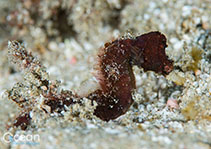| Family: |
Syngnathidae (Pipefishes and seahorses), subfamily: Syngnathinae |
| Max. size: |
4.66 cm SL (male/unsexed); 4.59 cm SL (female) |
| Environment: |
reef-associated; marine; depth range 22 - 50 m |
| Distribution: |
West Indian Ocean: South Africa, |
| Diagnosis: |
Dorsal soft rays (total): 15-15; Anal soft rays: 4-4. This species is distinguished by the following characters: with a supraoccipital bone bearing a highly derived and distinct diamond-shaped bony protuberance oriented anteriorly, rhombus-shaped in anterodorsal view, divided transversally into two sections by a ridge; knob-shaped midventral spine on the cleithral symphysis; blunt midventral spine on the first trunk ring between the pectoral-fin bases; thick dorsomedial crest-like ridge extending over the length of the first trunk ridge; median frontal spine at the convergence of anterior edges of the supraoccipital bone, anterior margin straight-edged; rugose double lateral head spine present below supraoccipital v; three supraorbital extensions or spines, anterior two a double spine and equal in size, the posteriormost spine large and oblong in shape; cleithrum continuous middorsally; presence of supracleithrum; no anterior and posterior nuchal plates, with large gap between the supraoccipital and cleithrum; small blunt midlateral spines proximally on the operculum; cleithral ring with two oval-shaped spines, one spine on anterior to ventral third of pectoral-fin base, the second spine at the ventral extent of the head; small spine on posterolaterally on the pelvic-fin base; four subdorsal spines, forming a square, the dorsal two enlarged, the ventral two small in size (Ref. 132073). |
| Biology: |
This species was observed in a protected sandy basins in otherwise exposed areas with accumulated debris near flat rocky reefs and were observed loosely associating with sandy worm casts, sponges, and small octocorals, using the sessile invertebrates as a holdfast for their prehensile tails (Ref. 132073). |
| IUCN Red List Status: |
Not Evaluated (N.E.) Ref. (130435)
|
| Threat to humans: |
harmless |
Source and more info: www.fishbase.org. For personal, classroom, and other internal use only. Not for publication.
